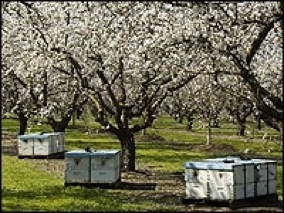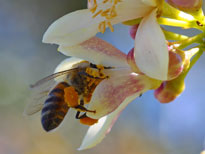


Bees are social insects. They live in colonies and depend upon each other. There are 50,000 bees in each hive. There are three types of bees in each hive, female workers, male drones, and one queen. Bees in just one hive will make 4.5 million trips to flowers in just one day. Also 1000 worker bees will die each day in the summer. California uses 1.4 million hives to pollinate its almonds. That’s over 50 billion bees.
Bees face many dangers. One that is getting worse is the parasitic mite called Acarapis woodi, Mites have 8 legs making them arachnids like spiders. They live in the bee’s breathing tubes and cause harm to the bee by sucking blood and fluids. This can kill the bee immediately or shorten its life. [25]
Modern use of pesticides and fungicides has caused great problems for bees. They are very sensitive to chemicals and refuse to go out and work in areas where chemicals are sprayed. Bee keepers have to remove the hives for 48 hours when orchards are sprayed. [7]
Honeybees are kept commercially. The wild bees that used to help in pollination are disappearing with their habitat, the woods and streams near orchards.
Pollination With Bees



Back to The Problem
Honeybees are an important pollinator for food production. A pollinator is an animal or insect that collects pollen and spreads it to other flowers. Some examples are bees, butterflies, moths, flies, wasps, and some nectar feeding bats.
Honeybees are the best pollinators. They are better than a lot of other insects because they search out pollen and carry it back to their hives. Other pollinators just seek out nectar. Bees use the pollen for their young. While doing this the pollen is spread to other flowers and fertilization happens. Pollen is taken from one flower to another flower and that causes the fruit to grow.
Bees use pollen baskets called Corbicul to collect pollen and carry it back to its hive. [24] Their legs are covered with hairs that attract the pollen and it falls off when the bee walks on other flowers. In one hectare of orchards you need five to eight colonies of bees for pollination. Three and a half million acres of crops in the U.S. are dependent on honeybees
The weather affects bees a lot. They won’t go out to forage if the temperature is below 11 degrees C. or in any kind of rain. Bees begin very active flying when the temperature is above 16 degrees C. Bees don’t forage much is the wind is above 23 km per hour. They also don’t go out as far from the hive if it is cloudy. [6]

Bees fill up their pollen basket and take the pollen back to the hive.
Pollen Magnified
Pollen Tubes


